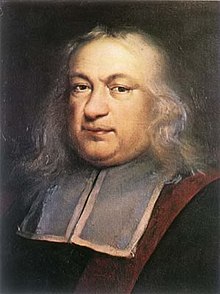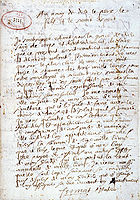Pierre de Fermat
Pierre de Fermat | |
|---|---|
 Pierre de Fermat, 17th century painting by unknown author | |
| Born | c. 1607 |
| Died | 12 January 1665 (aged 57) |
| Education | University of Orléans (BCL, 1626) |
| Known for | Contributions to number theory, analytic geometry, probability theory Folium of Descartes Fermat's principle Fermat's little theorem Fermat's Last Theorem Adequality Fermat's "difference quotient" method[1] (See full list) |
| Scientific career | |
| Fields | Mathematics and law |
Pierre de Fermat (French:
Biography

Fermat was born in 1607[a] in Beaumont-de-Lomagne, France—the late 15th-century mansion where Fermat was born is now a museum. He was from Gascony, where his father, Dominique Fermat, was a wealthy leather merchant and served three one-year terms as one of the four consuls of Beaumont-de-Lomagne. His mother was Claire de Long.[2] Pierre had one brother and two sisters and was almost certainly brought up in the town of his birth.[citation needed]
He attended the
In 1630, he bought the office of a
Fluent in six languages (
Work

Fermat's pioneering work in analytic geometry (Methodus ad disquirendam maximam et minimam et de tangentibus linearum curvarum) was circulated in manuscript form in 1636 (based on results achieved in 1629),[11] predating the publication of Descartes' famous La géométrie (1637), which exploited the work.[12] This manuscript was published posthumously in 1679 in Varia opera mathematica, as Ad Locos Planos et Solidos Isagoge (Introduction to Plane and Solid Loci).[13]
In Methodus ad disquirendam maximam et minimam et de tangentibus linearum curvarum, Fermat developed a method (
Fermat was the first person known to have evaluated the integral of general power functions. With his method, he was able to reduce this evaluation to the sum of geometric series.[16] The resulting formula was helpful to Newton, and then Leibniz, when they independently developed the fundamental theorem of calculus.[citation needed]
In number theory, Fermat studied
Although Fermat claimed to have proven all his arithmetic theorems, few records of his proofs have survived. Many mathematicians, including Gauss, doubted several of his claims, especially given the difficulty of some of the problems and the limited mathematical methods available to Fermat. His famous Last Theorem was first discovered by his son in the margin in his father's copy of an edition of Diophantus, and included the statement that the margin was too small to include the proof. It seems that he had not written to Marin Mersenne about it. It was first proven in 1994, by Sir Andrew Wiles, using techniques unavailable to Fermat.[citation needed]
Through their correspondence in 1654, Fermat and
The first
Death
Pierre de Fermat died on January 12, 1665, at Castres, in the present-day department of Tarn.[22] The oldest and most prestigious high school in Toulouse is named after him: the Lycée Pierre-de-Fermat. French sculptor Théophile Barrau made a marble statue named Hommage à Pierre Fermat as a tribute to Fermat, now at the Capitole de Toulouse.
-
Place of burial of Pierre de Fermat in Place Jean Jaurés, Castres. Translation of the plaque: in this place was buried on January 13, 1665, Pierre de Fermat, councillor at the Chambre de l'Édit (a court established by the Edict of Nantes) and mathematician of great renown, celebrated for his theorem,
an + bn ≠ cn for n>2 -
Monument to Fermat in Beaumont-de-Lomagne in Tarn-et-Garonne, southern France
-
Bust in the Salle Henri-Martin in the Capitole de Toulouse
-
Holographic will handwritten by Fermat on 4 March 1660, now kept at the Departmental Archives of Haute-Garonne, in Toulouse
Assessment of his work
Together with René Descartes, Fermat was one of the two leading mathematicians of the first half of the 17th century. According to Peter L. Bernstein, in his 1996 book Against the Gods, Fermat "was a mathematician of rare power. He was an independent inventor of analytic geometry, he contributed to the early development of calculus, he did research on the weight of the earth, and he worked on light refraction and optics. In the course of what turned out to be an extended correspondence with Blaise Pascal, he made a significant contribution to the theory of probability. But Fermat's crowning achievement was in the theory of numbers."[23]
Regarding Fermat's work in analysis, Isaac Newton wrote that his own early ideas about calculus came directly from "Fermat's way of drawing tangents."[24]
Of Fermat's number theoretic work, the 20th-century mathematician
See also
Notes
References
- ^ Benson, Donald C. (2003). A Smoother Pebble: Mathematical Explorations, Oxford University Press, p. 176.
- ^ a b "When Was Pierre de Fermat Born? | Mathematical Association of America". www.maa.org. Retrieved 2017-07-09.
- ^ W.E. Burns, The Scientific Revolution: An Encyclopedia, ABC-CLIO, 2001, p. 101
- ^ Chad (2013-12-26). "Pierre de Fermat Biography - Life of French Mathematician". Totally History. Retrieved 2023-02-22.
- ^ "Fermat, Pierre De". www.encyclopedia.com. Retrieved 2020-01-25.
- ^ Davidson, Michael W. "Pioneers in Optics: Pierre de Fermat". micro.magnet.fsu.edu. Retrieved 2020-01-25.
- ^ "Pierre de Fermat's Biography". www.famousscientists.org. Retrieved 2020-01-25.
- ISBN 978-0-618-87918-2.
- ISBN 978-1-4432-9487-4.
- MR 1335426.
- ^ Daniel Garber, Michael Ayers (eds.), The Cambridge History of Seventeenth-century Philosophy, Volume 2, Cambridge University Press, 2003, p. 754 n. 56.
- ^ "Pierre de Fermat | Biography & Facts". Encyclopedia Britannica. Retrieved 2017-11-14.
- ISBN 978-0393040029
- ^ Pellegrino, Dana. "Pierre de Fermat". Retrieved 2008-02-24.
- ^ Florian Cajori, "Who was the First Inventor of Calculus" The American Mathematical Monthly (1919) Vol.26
- Zbl 1162.01004. Archived from the originalon 2019-08-08.
- ^ O'Connor, J. J.; Robertson, E. F. "The MacTutor History of Mathematics archive: Pierre de Fermat". Retrieved 2008-02-24.
- ^ Eves, Howard. An Introduction to the History of Mathematics, Saunders College Publishing, Fort Worth, Texas, 1990.
- ISBN 978-0-19-501496-9.
- ^ "Fermat's principle for light rays". Archived from the original on March 3, 2016. Retrieved 2008-02-24.
- S2CID 115984858.
- ISSN 0036-6978. Vol 9, No 4, pp. 209-228.
- ISBN 978-0-471-12104-6.
- ISBN 978-0-88385-561-4.
- ^ Weil 1984, p.104
- ^ Weil 1984, p.105
Works cited
- Weil, André (1984). Number Theory: An approach through history From Hammurapi to Legendre. Birkhäuser. ISBN 978-0-8176-3141-3.
Further reading
- Barner, Klaus (December 2001). "Pierre de Fermat (1601?–1665): His life besides mathematics". Newsletter of the European Mathematical Society: 12–16.
- ISBN 978-0-691-03666-3.
- ISBN 978-1-84115-791-7.
External links
This article's use of external links may not follow Wikipedia's policies or guidelines. (June 2021) |
- Fermat's Achievements
- Fermat's Fallibility at MathPages
- The Correspondence of Pierre de Fermat in EMLO
- History of Fermat's Last Theorem (French)
- The Life and times of Pierre de Fermat (1601–1665) from W. W. Rouse Ball's History of Mathematics
- O'Connor, John J.; Robertson, Edmund F., "Pierre de Fermat", MacTutor History of Mathematics Archive, University of St Andrews





